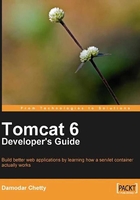
Chapter 1. Introduction to Tomcat
It is hard to overemphasize the importance of Apache Tomcat in the realm of Java Enterprise Edition web development. Tomcat began its life as source code that was donated by Sun Microsystems to the Apache Software Foundation (ASF). Since then, it has played a central role in the development and validation of the Java Servlet and JavaServer Pages specifications and has been the official reference implementation for these specifications.s
Its early popularity stemmed from the fact that it was easily integrated with two of the world's most popular web server software, Apache httpd and Microsoft's Internet Information Services (IIS) server.
However, since then, it has evolved into a production-grade product used by multiple large corporations (see a partial list at http://wiki.apache.org/tomcat/PoweredBy).
Tomcat is also found embedded, in part or whole, in various open source application server offerings. Even when using competing commercial application server offerings such as IBM's WebSphere and BEA's WebLogic, developers often use Tomcat to validate the vendor-independence of their applications.
It is also priced just right. It is open source and distributed under the Apache license, meaning it is free for use and modification (see www.apache.org/licenses for details). This also has the side effect of having the source code readily available for examination.
This availability of source code, strict adherence to specifications, and proven track record, combine to make Tomcat a unique learning opportunity for us. This book will assist you in taking the covers off this unique project, so that you get to see exactly how a production-grade servlet container is implemented.